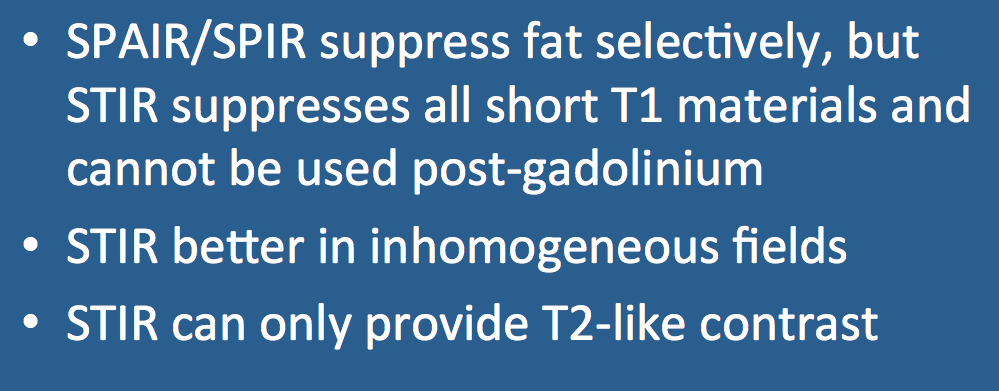SPIR and SPAIR differ from STIR in several respects: (1) STIR is a complete sequence, whereas SPIR/SPAIR can be thought of as a type of preparatory module that can be appended to other sequences; (2) SPIR/SPAIR selectively suppresses fat, whereas STIR suppresses all tissues with T1 values similar to fat; (3) SPIR/SPAIR can be performed only in highly homogeneous magnets, whereas STIR is applicable at all field strengths and over a wide range of homogeneities. (4) STIR can be used only to produce images with T2-like contrast, whereas SPIR/SPAIR can be used with sequences of any weighting. (5) SPIR/SPAIR sequences have higher signal-to-noise than STIR.
Difference (2) above bears special emphasis and elaboration. STIR sequences result in a nonselective suppression of fat as well as other tissues with short T1 values. STIR will tend to hide gadolinium enhancement (since gadolinium-containing tissues may have T1 values shortened into the fat range.) SPIR, however, through its selective suppression of fat is widely used for postcontrast MR imaging.
Difference (2) above bears special emphasis and elaboration. STIR sequences result in a nonselective suppression of fat as well as other tissues with short T1 values. STIR will tend to hide gadolinium enhancement (since gadolinium-containing tissues may have T1 values shortened into the fat range.) SPIR, however, through its selective suppression of fat is widely used for postcontrast MR imaging.
Advanced Discussion (show/hide)»
No supplementary material yet. Check back soon!
References
Del Grande F, Santini F, Herzka DA, et al. Fat-suppression techniques for 3-T MR imaging of the musculoskeletal system. RadioGraphics 2014; 34:217-233. (Good recent review, focused on the musculoskeletal system).
Horger W. Fat suppression in the abdomen. MAGNETOM Flash 2007;3:114-119. (Good overview of multiple techniques, obviously focused exclusively on Siemens' products).
Kaldoudi E, Williams SC, Barker GJ, Tofts PS. A chemical shift selective inversion recovery sequence for fat-suppressed MRI: theory and experimental validation. Magn Reson Imaging 1993; 11:341-355.
Krinsky G, Rofsky NM, Weinreb JC. Nonspecificity of short inversion time inversion recovery (STIR) as a technique of fat suppression: pitfalls in image interpretation. Am J Roentgenol 1996; 166:523-526.
Del Grande F, Santini F, Herzka DA, et al. Fat-suppression techniques for 3-T MR imaging of the musculoskeletal system. RadioGraphics 2014; 34:217-233. (Good recent review, focused on the musculoskeletal system).
Horger W. Fat suppression in the abdomen. MAGNETOM Flash 2007;3:114-119. (Good overview of multiple techniques, obviously focused exclusively on Siemens' products).
Kaldoudi E, Williams SC, Barker GJ, Tofts PS. A chemical shift selective inversion recovery sequence for fat-suppressed MRI: theory and experimental validation. Magn Reson Imaging 1993; 11:341-355.
Krinsky G, Rofsky NM, Weinreb JC. Nonspecificity of short inversion time inversion recovery (STIR) as a technique of fat suppression: pitfalls in image interpretation. Am J Roentgenol 1996; 166:523-526.
Related Questions
What is STIR?
What is SPIR and how does it compare to other fat suppression methods?
What is SPAIR? How is it different than SPIR?
There seem to be many methods available for fat suppression. Which one is the best?
What is STIR?
What is SPIR and how does it compare to other fat suppression methods?
What is SPAIR? How is it different than SPIR?
There seem to be many methods available for fat suppression. Which one is the best?
